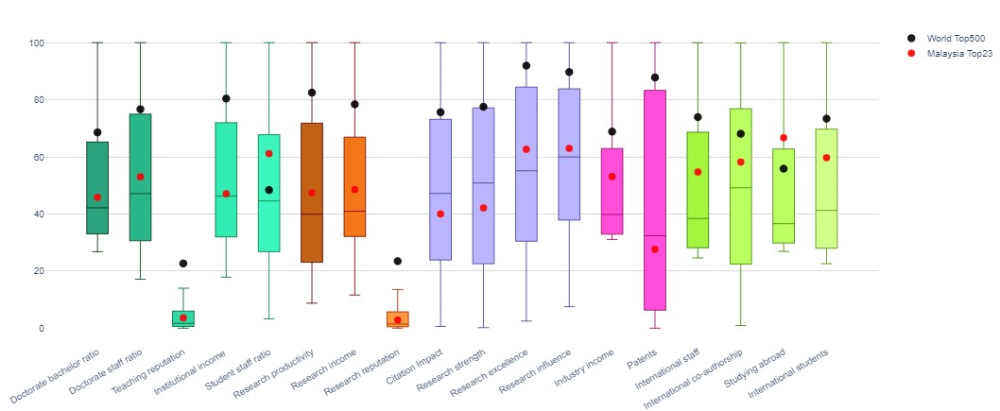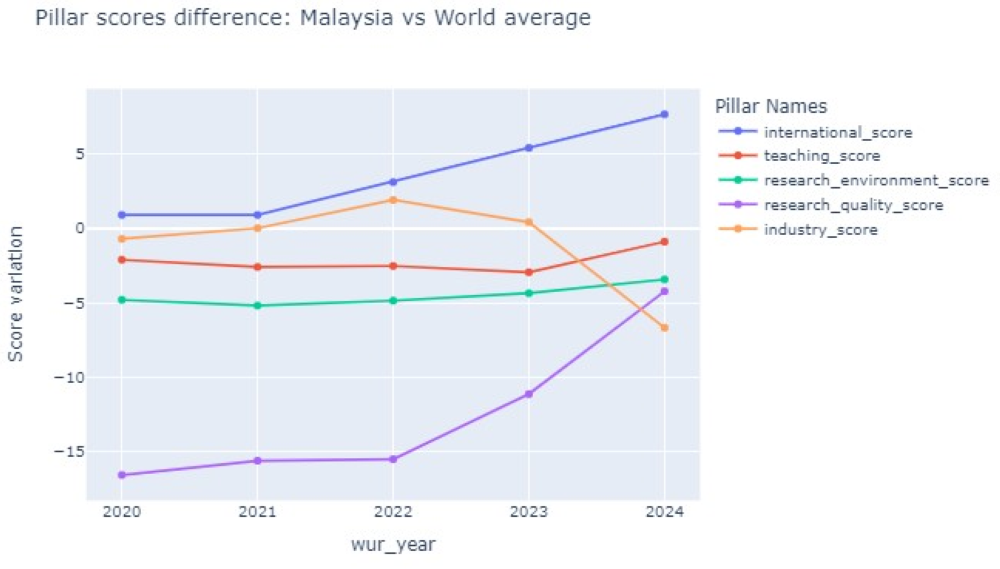KUALA LUMPUR, Sept 27 — Seven of Malaysian universities are now ranked as being among the best 500 universities in the world, including the country’s oldest varsity Universiti Malaya (UM) that broke into the top 251 to 300 band in a global ranking of 1,904 universities.
UM, which is 118 years’ old and the highest-ranked university in Malaysia, had its best-ever ranking in the Times Higher Education’s (THE) World University Rankings 2024.
Moving up from band 351-400 in the 2023 rankings to the band 251-300 in the 2024 global rankings, this means UM is now ranked among the top 15 per cent of universities in the world.
This is UM’s highest ranking since it became part of this global ranking in 2018, as it was only twice within the 351-400 band (2018 and 2023) and in the 301-350 band for the four other years.
The second-highest ranking local institution Universiti Teknologi Petronas is rapidly catching up with UM with an improved placement in the 301-350 band in this year’s rankings, while Universiti Kebangsaan Malaysia (UKM), Universiti Sains Malaysia (USM), Universiti Teknologi Malaysia (UTM) and Universiti Utara Malaysia (UUM) are all in the 401-500 band.
This was followed by Universiti Putra Malaysia (UPM) in the 501-600 band.
The four other universities in Malaysia in the top half of the 1,904 varsities ranked are Universiti Tenaga Nasional (UNITEN), Universiti Pendidikan Sultan Idris (UPSI), Universiti Malaysia Pahang (UMPSA) and Sunway University. All four were in the 601-800 band in the 2024 rankings, an improvement from the 801-1,000 band from last year.
In other words, apart from UUM which maintained its ranking, all the other top 10 universities in Malaysia went up in their rankings in the 2024 rankings.
THE’s chief global officer Phil Baty highlighted the impressive rise of Malaysia’s universities in the global rankings.
“Malaysian universities made significant gains in THE’s World University Rankings 2024 with almost every institution in the top 10 making big improvements.
“The country, impressively, now has six universities in the top 500. Malaysian universities’ rapid trajectory up the rankings over the last five year has really captured international attention,” he said in a statement on the 2024 world rankings released tonight.
“Recently, Malaysian universities have been keen to build their international student and staff numbers to enhance their global footprint and build their global reputation, which is likely to result in even further improved performances in the rankings over the coming years. Malaysia is cementing its status as a major global education hub,” he added.
The number of Malaysian universities that are part of THE’s World University Rankings have grown over the years, with 13 in 2020, 15 in 2021, 18 (2022), 22 (2023), and 23 (2024).

The THE’s World University Rankings which initially looked at only 200 universities is now in its 20th edition.
The 2024 edition of the rankings is the largest as it ranked 1,904 universities from 108 countries and regions, which means an additional 105 universities were included and up from the 1,799 universities ranked in the 2023 rankings.
For the global ranking, its methodology was significantly changed for the 2024 rankings, which may have influenced changes to the scores of some universities this year compared to the previous year. The last substantial change to the methodology was in 2011.
The 2023 rankings previously used 13 performance indicators to evaluate universities, while the 2024 rankings used 18 performance indicators which are spread out over five pillars or five categories.
These are namely the five pillars of teaching (teaching reputation, the ratio of full time staff to full time students, the ratio of doctorates to undergraduate degrees awarded, the doctorate staff ratio, institutional income); research environment (research reputation, research income, research productivity); research quality (citation impact and the three new indicators of research strength, research excellence, research influence); international outlook (international students, international staff, international co-authorship and the new indicator of studying abroad based on the number of exchange students going abroad); and industry (industry income and the new indicator of patents).

The 23 Malaysian universities scored above average and performed better than the world’s top 500 universities in the ranking for the indicators of student-staff ratio and studying abroad in the 2024 rankings.
But the study abroad indicator, which measures the provision of international learning opportunities for local students, was given zero weight in the 2024 rankings. This is a temporary move, due to the impact of Covid-19 on international travel.
“In the international pillar Malaysian universities perform better than the world average with a steady growth since 2021 and in the research and teaching pillars they are also rising over time, while in the industry pillar they are declining,” THE’s World University Rankings said.

Beyond the top 200 universities globally, THE’s World University Rankings places and scores other universities in bands or within a range.
In UM’s case, for instance, it is ranked between 251-300 among all the universities, and has an overall score of 53.1-55.8.
To calculate the overall score, each individual score must be combined with the weight given before totalling it up.
For UM, its highest score was in the international pillar at 84.7, but the weight of only 7.5 per cent to this pillar translated to a 6.35 score. The highest weightage is given to the teaching, research environment and research quality pillars, which translated to scores of 12.8, 10.27 and 21.78 after weight was taken into account. Combined with 2.1 weighted score for industry, that would give UM an overall score of around 53.3.
While the top seven universities in Malaysia had the highest score in the international pillar, this carried little weight, and the research quality pillar was instead the single biggest contributor to their overall score after taking into account the weight given.
Here’s how the top seven universities in Malaysia performed in the five pillars:
In the 2024 rankings, the top 10 universities in the world are either from the UK or US, namely the UK’s University of Oxford (first), University of Cambridge (fifth), Imperial College of London (eighth), while the rest are from the US namely Stanford University (second), Massachusetts Institute of Technology (third), Harvard University (fourth), Princeton University (sixth), California Institute of Technology (seventh), University of California, Berkeley (ninth) and Yale University (10th).
In the top 100 universities in the 2024 rankings, apart from the US and UK, there were also universities from Switzerland, China, Singapore, Canada, Japan, Germany, Hong Kong, Australia, France, Belgium, Netherlands, Sweden, South Korea, and Russia.
The top 100 universities include National University of Singapore (ranked 19th) and the Nanyang Technological University, Singapore (ranked 32nd).



















